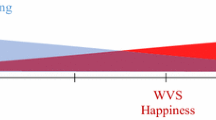Abstract
This paper presents a ‘system’, i.e. systematic compilation, of about 200 social indicators in 10 areas of life, for the Federal Republic of Germany, 1955–1975. The construction of this indicator system is explained and an abridged version is introduced that can be comprised into one master table. Next, an overall evaluation of welfare development in West Germany is given and four models for a time-sequence interpretation are discussed. Finally, the present effort is put in perspective, e.g. in regard of the OECD program and of recent quality-of-life survey research.
Similar content being viewed by others
Author information
Authors and Affiliations
Additional information
This paper was commissioned by UNESCO, Division for Socio-economic Analysis, for the Meeting of experts on Indicators of the interrelationships of social and economic development, Paris, 10–13 April 1978. An earlier German version was read at the 1977 Verein für Socialpolitik meeting. This work is part of the SPES project (‘Sozialpolitisches Entscheidungs- und Indikatorensystem für die Bundesrepublik Deutschland’) of the Social Policy Research Group at Frankfurt and Mannheim universities.
Rights and permissions
About this article
Cite this article
Zapf, W. Applied social reporting: A social indicators system for West German Society. Soc Indic Res 6, 397–419 (1979). https://doi.org/10.1007/BF00289435
Received:
Issue Date:
DOI: https://doi.org/10.1007/BF00289435




